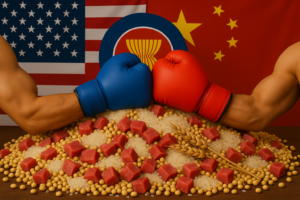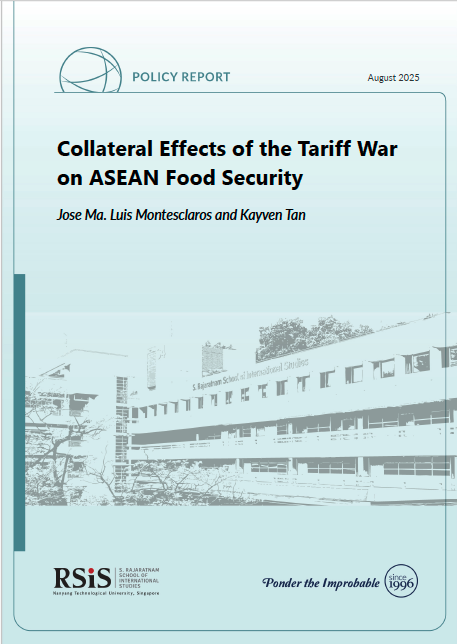19 August 2025
- RSIS
- Publication
- RSIS Publications
- Collateral Effects of the Tariff War on ASEAN Food Security
Executive Summary
This policy report examines the potential collateral effects of the US-China tariff war on the food security of the Association of Southeast Asia Nations (ASEAN) member states, who are third parties to the conflict. Across the six commodities studied – soybeans, maize, wheat, poultry meat, pork, and bovine meat (beef) – China’s 10% retaliatory tariffs on the US will likely divert US$1.16 billion (2.3 million tonnes) of food imports. Brazil, Russia, South Africa, Argentina, Canada, Australia, and New Zealand will feature significantly among China’s alternative sources. ASEAN’s greatest vulnerabilities lie in soybeans, wheat, and maize, relative to the meat products. The most vulnerable ASEAN countries are those that also import from China’s alternative (non-US) sources, as they are likely to face reduced imports, higher import prices, or both. To prepare for potential worse scenarios including a collapse in the trade war truce talks, or sudden import/export surges triggering price instability and trade bans, regional policymakers should prioritise providing sufficient income support to consumers, and helping ASEAN farmers and traders to raise regional production levels, to benefit from higher prices and incomes.

Executive Summary
This policy report examines the potential collateral effects of the US-China tariff war on the food security of the Association of Southeast Asia Nations (ASEAN) member states, who are third parties to the conflict. Across the six commodities studied – soybeans, maize, wheat, poultry meat, pork, and bovine meat (beef) – China’s 10% retaliatory tariffs on the US will likely divert US$1.16 billion (2.3 million tonnes) of food imports. Brazil, Russia, South Africa, Argentina, Canada, Australia, and New Zealand will feature significantly among China’s alternative sources. ASEAN’s greatest vulnerabilities lie in soybeans, wheat, and maize, relative to the meat products. The most vulnerable ASEAN countries are those that also import from China’s alternative (non-US) sources, as they are likely to face reduced imports, higher import prices, or both. To prepare for potential worse scenarios including a collapse in the trade war truce talks, or sudden import/export surges triggering price instability and trade bans, regional policymakers should prioritise providing sufficient income support to consumers, and helping ASEAN farmers and traders to raise regional production levels, to benefit from higher prices and incomes.






